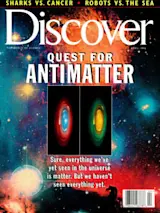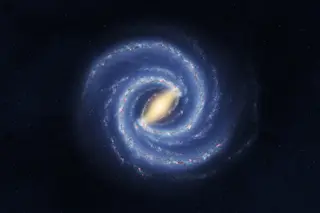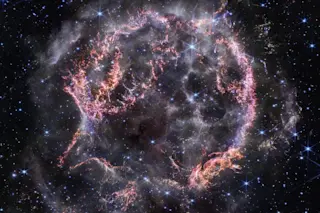Carbon is the stuff of life. And our solar system seems to be much more generously endowed with it than most other parts of the galaxy.
Just about everywhere you look in the solar system, you find carbon: from the searing atmosphere of Venus to the oily slush of Titan to the hair of the dog that bit you. In fact, carbon is the fourth most common element in the solar system after hydrogen, helium, and oxygen. And since astronomers consider our solar system to be fairly mundane, most of them assume that carbon is just as common in the rest of the galaxy. But a recent reexamination of the composition of about 200 ordinary stars in the Milky Way has shown that our sun contains much more carbon than most of its neighbors. Our sooty home is apparently something of a carbon oasis.
This new assessment of carbon’s abundance comes from astrophysicists Ted Snow of the University of Colorado and Adolf Witt of the University of Toledo. They examined data from a dozen recent surveys of both young and middle-aged stars and were surprised by the paucity of carbon in these stars. I don’t think we found a single case of another star with the solar carbon abundance, Snow says.
Carbon forms from the fusion of helium nuclei in the cores of old, giant stars. When those stars explode as supernovas, their carbon is scattered into space along with other, heavier elements. Thus all the carbon that astronomers can see on the surface of our sun and other nearby stars today is believed to have come from earlier generations of stars; when they died, they enriched the clouds of gas and dust from which the present stars were born. If anything, stars younger than the sun should contain more carbon than it does, because the clouds that gave rise to them had longer to be enriched by supernovas. Snow and Witt, however, peg the average stellar carbon concentration at between 175 and 275 carbons for every million atoms of hydrogen; the concentration in the sun is about 355 per million.
Because astronomers have always assumed that our sun and solar system are nondescript galactic citizens, many models of how the galaxy works have been geared toward explaining what we see in our own backyard. But if average stars have from half to three-quarters as much carbon as the sun, astronomers may have to reexamine some basic assumptions. For example, the dimming of starlight as it travels through space has been attributed to scattering by carbon-rich interstellar dust. The current models appear to require more carbon to do this than we think is available, Snow says. Rather than consisting of microscopic grains of pure carbon--graphite or diamond--as some theorists have suggested, the dust may be a mixture of silicon, oxygen, and hydrogen as well as carbon.
Does a carbon deficit decrease the likelihood of carbon-based life arising elsewhere in the galaxy? Planetary scientist John Lewis of the University of Arizona, an expert on the chemistry of the early solar system, doesn’t think so. Our solar system, he points out, has natural mechanisms for forming rich pockets of carbon--they’re called comets, and they’re carbon-rich because they formed far enough from the sun for carbon to solidify rather than evaporate into space, as it tended to do in Earth’s neighborhood. Current models suggest that most of the carbon at Earth’s surface and in its biosphere came to the planet in a rain of comets early in its history, not long after it cooled. Half or more of Earth’s carbon was brought in by the largest cometary impactor, Lewis says, so a single event can change the entire history of a planet. Even carbon-poor star systems, he says, might have comets with relatively high concentrations of carbon. Any planets in such systems could get all the carbon needed for life from a few fortuitous impacts.
All well and good, but how did our star come to be endowed with more carbon than its neighbors? The sun is rich in iron, oxygen, and a number of other elements besides carbon, Snow says. You can expect this sort of general enhancement across the board from a supernova. Such an explosion need not evenly distribute a dying star’s contents, and our solar system may have formed from a clump of gas especially rich in carbon and oxygen--which just happen to be the stuff of life. Says Snow: There could have been something very local and specialized that happened here.














